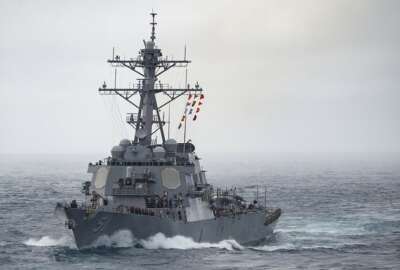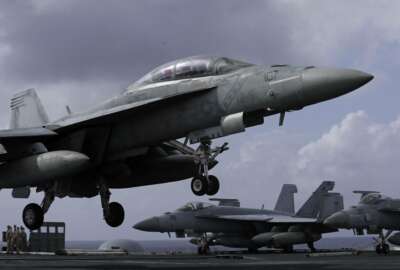
Navy to unplug decades-old personnel IT systems, clear way for app-based self service
The Navy says dozens of IT systems and websites for pay and personnel functions are about to be killed off in favor of a consolidated system sailors can access ...
Best listening experience is on Chrome, Firefox or Safari. Subscribe to Federal Drive’s daily audio interviews on Apple Podcasts or PodcastOne.
The Navy says it’s just about ready to pull the plug on its antique collection of dozens of disparate IT systems that handle manpower and personnel matters. Some are five decades old, and officials believe the commercial architecture that’s about to replace them will open the door to a modern, app-based personnel system.
As of now, the IT infrastructure that supports the Navy’s manpower and training needs is made up of 55 separate systems. Ten of those are at least 30 years old, and incremental upgrades over time have only made them more complex and expensive to maintain. The software they run is written in 21 different programming languages, riding on nine different operating systems spread across 73 data centers and networks.
The Navy has been gradually moving some of its personnel-related technology to a common architecture called the Navy Pay and Personnel System (NP2) since 2017. But Vice Adm. Robert Burke, the chief of naval personnel, said the pace will pick up over the next six to eight months.
“It’s really going to take us into the 21st century. We’ll finally be able to start unplugging our 1960s-era personnel systems that frankly are holding us back in the way that we do customer service,” he told sailors in a Facebook Live presentation. “This system is going to integrate everything with an authoritative data environment and bring all of our personnel and training systems into that one single system.”
Related Stories

Navy sees upcoming NGEN contract as opportunity to ‘rip and replace’ NMCI’s fundamental architecture
And by September, the service plans to start using the new system for all of its travel claims.
“A mobile app will do your travel claim electronically. You’re going to take pictures of your receipts — and when you do a stop at a hotel or you do training, it’s just going to upload it, so there’s nothing to collect at the end. It’s already in your phone,” Burke said. “And then when you get to your final destination, when you check in, the (Command Pay and Personnel Administrator) is not going to have to do anything, because you’re going to get a little QR code like your boarding pass on your mobile phone. Your travel claim gets liquidated right then, and it’ll be done in about 48 hours. Today, because we’re on so many different systems, no two of which talk to each other, everything has to get fat-fingered between those systems all over the country. It leaves a lot of room for error when people have to manually type it into different systems.”
More mobile apps are planned for release this summer, including ones for military spouses and to help manage permanent change of station moves.
But the new IT infrastructure is heavily-geared toward mobile apps as a general matter. The Navy has already built several other apps for sailors to handle tasks like career management, scheduling training, requesting leave and updating personnel records. For now, in many cases, they’re still tied to the Navy’s back-end legacy systems.
But officials say they intend to let sailors handle virtually any personnel transaction they need via a mobile device, and without the need for a Common Access Card to authenticate themselves. The plan is to consolidate 62 separate websites into desktop and mobile versions of the My Navy Portal. And by the end of the year, users will be able to access all of the functions via commercial two-factor authentication technologies instead of a CAC.
“Everything’s going to be app-based,” Burke said. “Everything will be an app from this point forward, and all running on NP2. But the other thing is when we find out we need to change something, it’s not going to be the standard Navy response: ‘submit your configuration change request and maybe four years from now you’ll see it.’ We’ll get the feedback, and if it’s something we need to change, we’re going to change it the next day. We’re going to have that capability, because the systems are that agile.”
The Navy is also restructuring the management of its personnel IT systems.
As of now, their program management responsibilities are as disjointed as the systems themselves. A majority of the 55 are handled by the Bureau of Personnel and the Naval Education and Training Command, with the remaining 22 falling under the control of the Program Executive Office for Enterprise Information Systems.
Going forward, PEO-EIS will take over management responsibility for all personnel-related technology systems. It’s conducting seven separate pilot projects this year as it works to consolidate the Navy’s ten separate personnel “data warehouses” into a single, authoritative data environment.
In the meantime, it’s working to move both that data environment and the new, centralized system that relies on it to the commercial cloud, said Julianne Lefevre, the deputy program manager for PEO-EIS’s Sea Warrior program.
“We’re focusing on a new operating model,” she told an audience at the Department of the Navy CIO’s conference in San Diego earlier this year. “We’re looking at a full set of analytic capability as well as sailor-friendly self service, and we’re also looking to save money. Why are we doing this? We have to have a return on our investment … it requires that we move from our environment of systems that are expensive to maintain, that are not fully integrated, that lack needed capabilities, or are not auditable. So we’ll be moving to a future environment of systems that have optimized processes, are cloud based, increased self service capabilities, and don’t require a CAC.”
Copyright © 2024 Federal News Network. All rights reserved. This website is not intended for users located within the European Economic Area.
Jared Serbu is deputy editor of Federal News Network and reports on the Defense Department’s contracting, legislative, workforce and IT issues.
Follow @jserbuWFED




